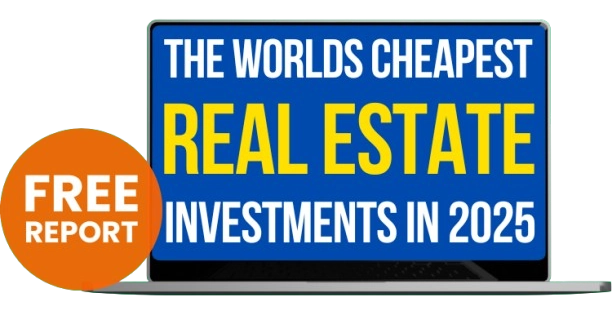World events are creating chaos and uncertainty… which is translating into the greatest opportunity of our lifetimes to own real estate overseas. The currency discounts alone are irresistible.
However, if you’re considering (as we strongly recommend you should be right now) diversifying into foreign property markets for the first time, you might rightly feel intimidated or overwhelmed. How, exactly, do you buy a piece of real estate in another country?
You arm yourself with a good understanding of how foreign property markets work. We’re here to help.
That’s why, over the past several days, we’ve been reviewing the fundamentals of navigating real estate markets overseas. We’ve looked at how to understand how much it should cost you to buy what you’re looking to buy when shopping in a market without a multiple listing service (which is most of the world outside the United States).
We’ve reviewed our standard due diligence checklist.
Today I’d like to continue our How To Buy Property Overseas Primer by pointing out that really cheap isn’t necessarily a good deal.
A friend recently forwarded information to me about cheap lots on a Caribbean island. Prices started at US$7,550. That’s an attention-getter, right?
In fact, this sounds-too-good-to-be-true offer (like every such offer I’ve come across in 35 years seeking out real estate investment opportunities overseas) is just that—too good to be true.
Property this cheap generally falls short on some or all of the three points that matter in any property investment—location, size, and infrastructure.
In the case of the Caribbean lots I’m thinking of, upon closer inspection, I found that they were not, in fact, Caribbean lots. They were lots on an island in the Caribbean, true, but they were far from the sea.
They also lacked infrastructure and were being sold without an access road and without electricity. The developer promised to build a way in, but, once built (I’d suggest, if built), it would be up to the lot owners to maintain the access.
The developer never intended to provide electricity to the lots. His plan was to put up poles. The electric company, he suggested, would have to come behind him to string the wire and flip the switch.
Finally, the lots were really small—about 1/10th an acre. That is 418 square meters, or 4,500 square feet. The developer suggested that a buyer might want to invest in more than one if he intended to build a house.
Bottom line, I’m not sure you’d want one of these lots if someone offered to give it to you free, not once you’d factored in all the costs you would incur to hold and maintain the lot, never mind the costs associated with actually trying to build on the lot and live in this “development,” which was located well outside the town services area. You would have to provide your own water and wastewater systems.
To be fair, the developer addressed these issues openly on his website. In fact, he was more up-front than many foreign property developers I’ve had experience with over the years.
Still, you’ve got to know how to interpret what you’re being told.
In this case, would-be owners were advised that their best option for potable water would be to catch rainwater and store it in a cistern. That can work, but, again, you’ve got to add the associated costs to the price of the lot to be able to make a fair comparison to the price of a lot in a development where central water is being provided.
In addition, purchasers of these lots had to install their own septic systems to deal with wastewater. OK, fair enough, but, remember, each of these lots is only 4,500 square feet. That’s not a lot of space to work with. And a septic system is another cost that, again, needed to be added to the price of a lot to make a realistic comparison to the cost of a lot in a development providing central wastewater.
How do you compare prices for lots in different developments where the services and amenities vary greatly? You essentially have to do your own appraisal. Start with the lot price, add in the costs of the extras you’ll have to provide yourself (for example, water and wastewater), and then divide the total cost by the number of square meters being purchased.
Let’s look at another example, two developments I know on the coast of Panama. One is a master-planned community with full infrastructure and amenities. The other is a basic lotification providing a central road and electricity.
The lotification project is selling ocean-view lots at US$30 a square meter. The average size is 3,000 square meters, meaning an average lot cost of US$90,000. While owners have access to above-ground electricity in this development, you have to make the connection to the nearest pole yourself.
You also have to drill your own well or design a catchment system for drinking water, and you have to install your own septic system. If you want internet, you’ll have to provide that, too. In this case, that means a satellite system.
The total cost for these services would be about US$15,000, meaning your US$90,000 lot would, in fact, cost you about US$105,000. That is, US$35 per square meter, as opposed to the US$30 advertised. That’s almost 20% more than the list price. That for a lot in a development with no amenities (no clubhouse, no central pool, no restaurant, etc.) and no direct access to the beach.
The master-planned community I’m thinking of on this same coast is selling lots for US$44 a square meter. Included among the amenities are central water, central wastewater management, underground electricity to each lot, paved roads, and central internet access. In addition, the plan calls for a clubhouse and a long list of other amenities. Plus, this property includes about a kilometer of beachfront, to which every lot owner has direct access.
On the other hand, amenities and services must be maintained. In the planned community, you’ll have higher HOA fees than as an owner in the lotification, where the only thing to maintain are the dirt roads.
I indicated above that you might not want one of the “Caribbean” lots I was describing if someone offered it to you free. The associated hassles and carrying costs wouldn’t be worth it to me, but you might have different priorities and objectives. A super-cheap lot like this one could make sense for you, depending on your circumstances.
My point is to be sure you know what you’re really buying and what it’s really going to cost you, all told. When shopping and considering options, make sure you’re comparing apples to apples, one location to another, one property to another, as best you can.
Kathleen Peddicord

















